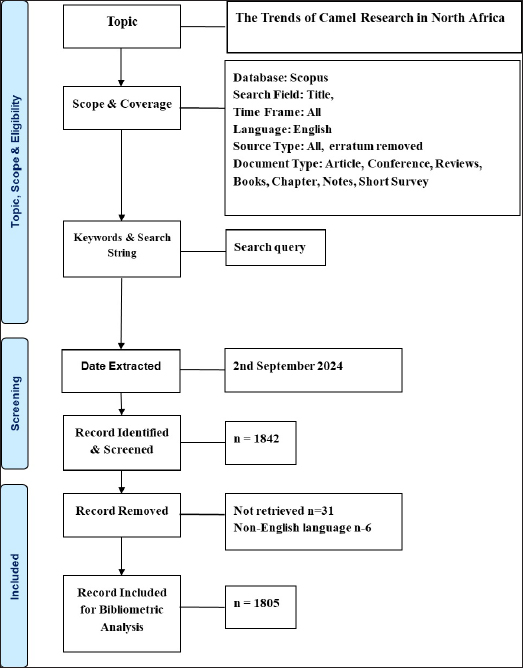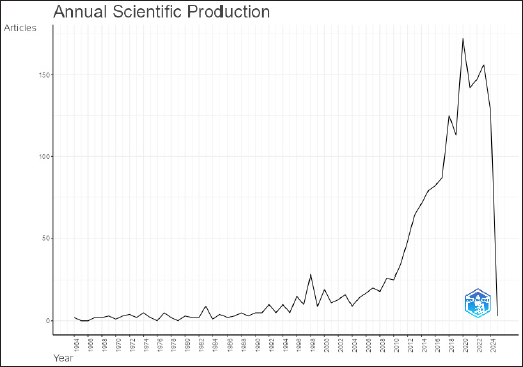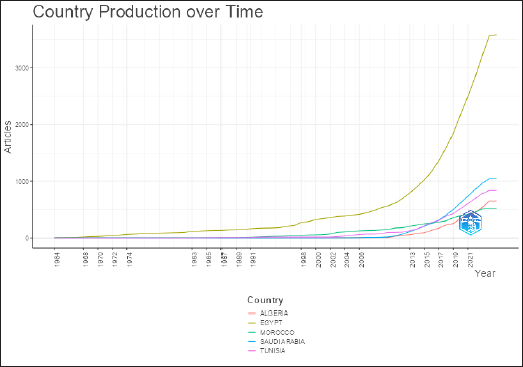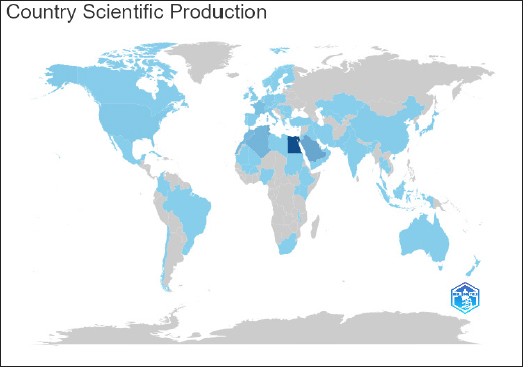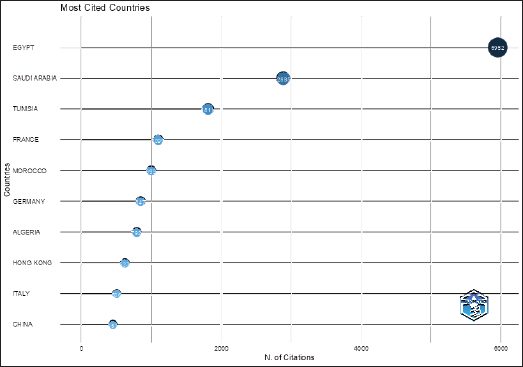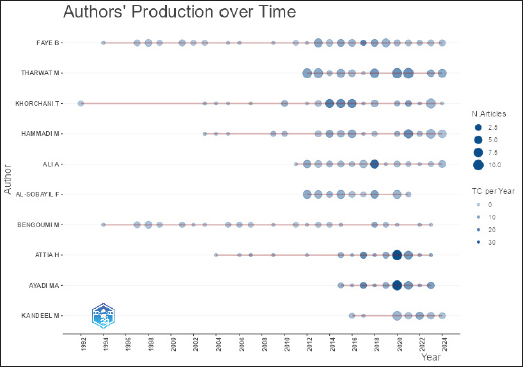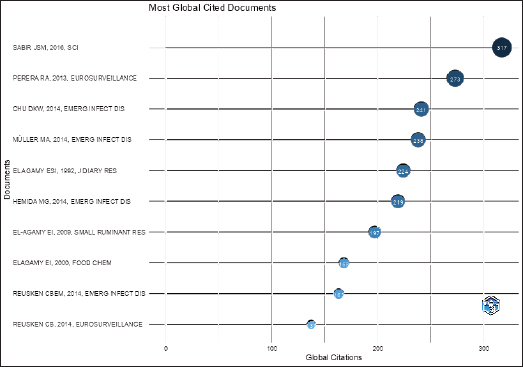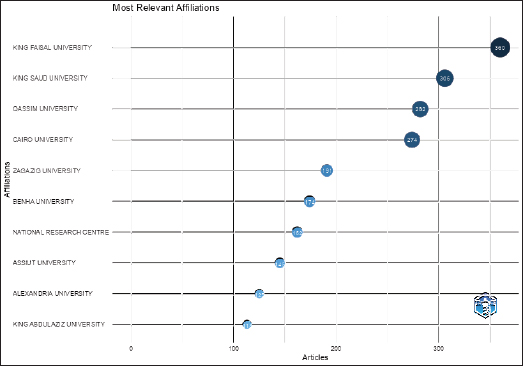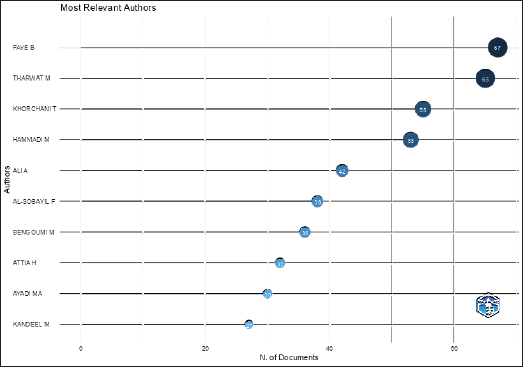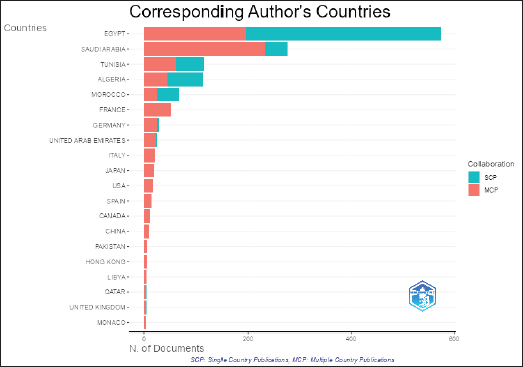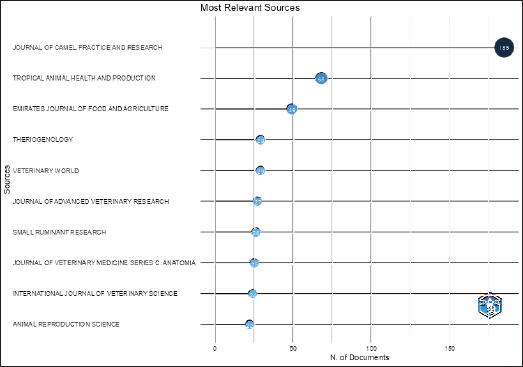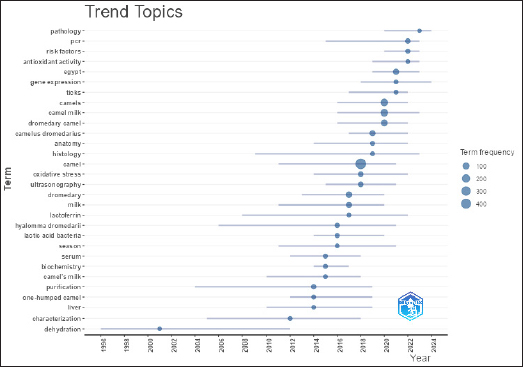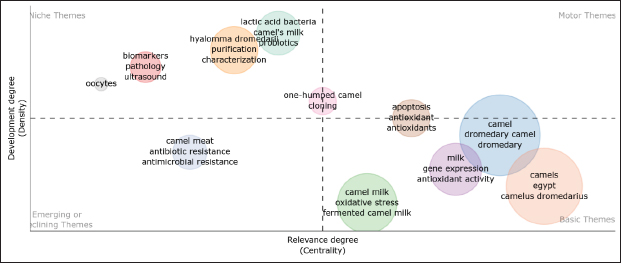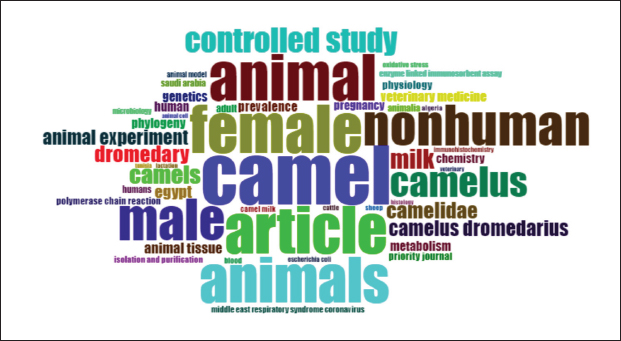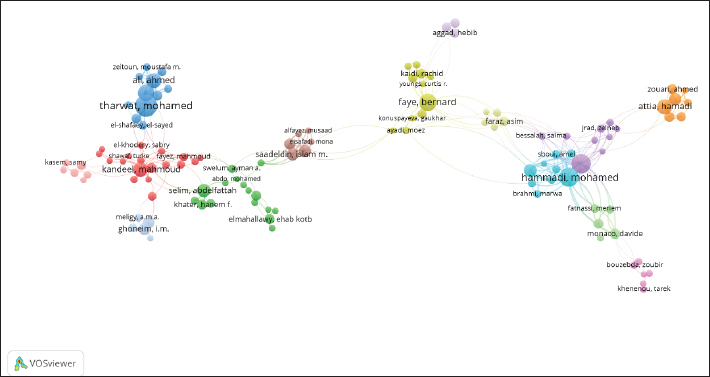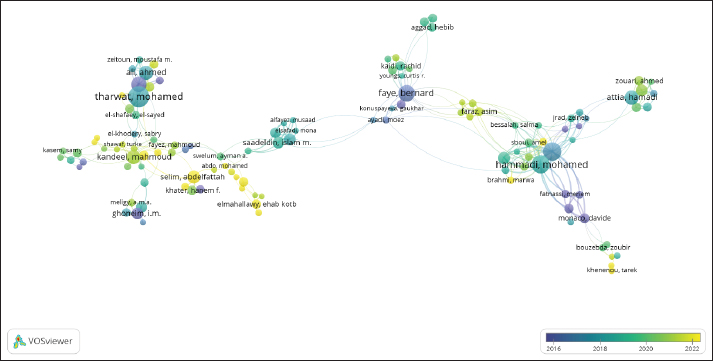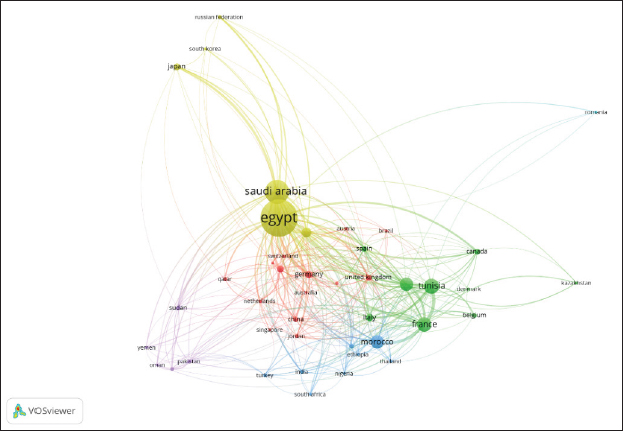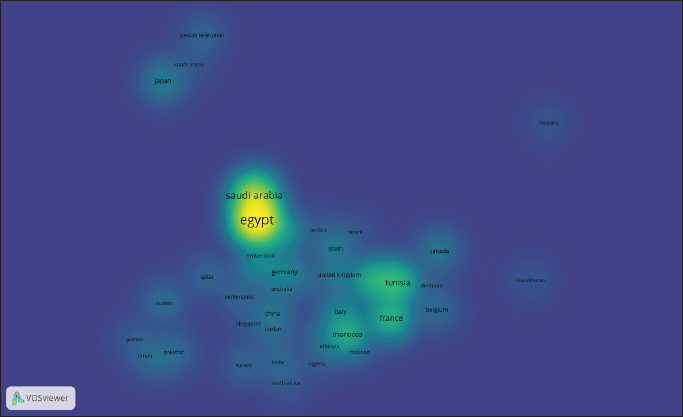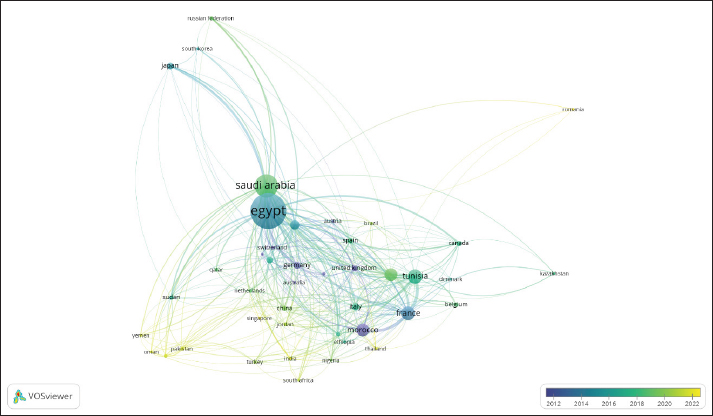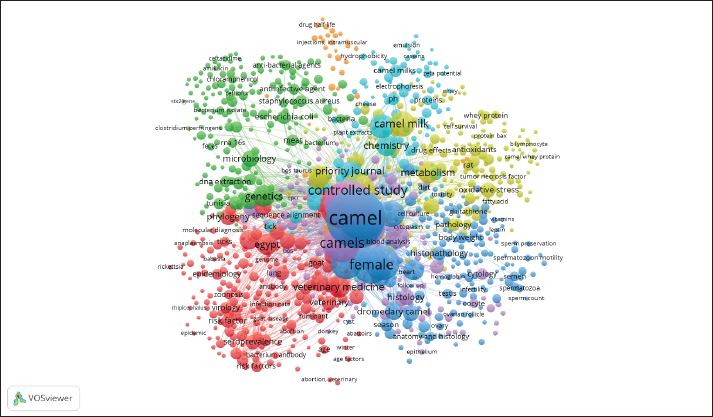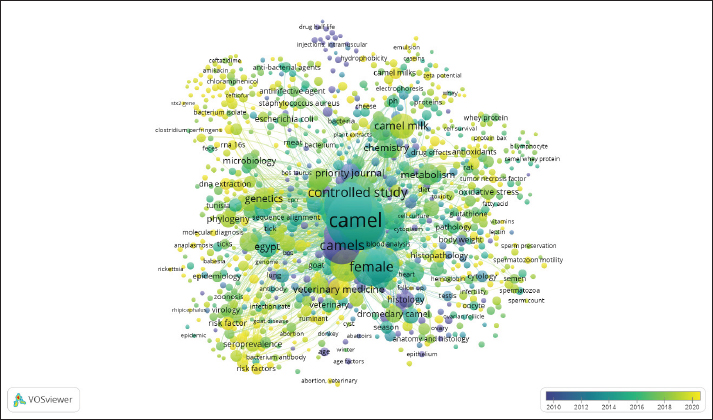
| Research Article | ||
Open Vet. J.. 2024; 14(12): 3505-3524 Open Veterinary Journal, (2024), Vol. 14(12): 3505-3524 Research Article A bibliometric analysis of six decades of camel research in North Africa: Trends, collaboration, and emerging themesRazan Naji1, Mahmoud Kandeel2* and Maryam Mahmoud31College of Veterinary Medicine, King Faisal University, Al-Ahsa, Saudi Arabia 2Department of Biomedical Sciences, College of Veterinary Medicine, King Faisal University, Al-Ahsa, Saudi Arabia 3College of Medicine, Delta University for Science and Technology, Gamasa, Egypt *Corresponding Author: Mahmoud Kandeel. Department of Biomedical Sciences, College of Veterinary Medicine, King Faisal University, Al-Ahsa, Saudi Arabia. Email: mkandeel [at] kfu.edu.sa Submitted: 22/10/2024 Accepted: 26/11/2024 Published: 31/12/2024 © 2024 Open Veterinary Journal
AbstractBackground: Camels play a crucial role in North Africa’s economy and agriculture, providing essential products, transportation, and tourism. Aim: This study conducts a comprehensive bibliometric analysis of camel research in North Africa between 1964 and 2024. The primary objectives are to evaluate research productivity, identify key contributors, and highlight emerging trends. Methods: Data were collected from the Scopus database, which contained 1805 research documents. Bibliometrix and VOSviewer were used to visualize co-authorship networks, citation patterns, and keyword trends. Results: The research output has increased dramatically since the mid-2000s, with a peak in publications between 2018 and 2020. Collaborations made up 53.91% of articles. The research clusters in camel studies from North Africa include camel physiology and reproduction, focusing on topics such as ovarian function, semen preservation, and seasonal variations; Microbiology and genetics, addressing microbial infections and genetic diversity; Epidemiology and disease control, which covers studies on disease prevalence, risk factors, and seroprevalence; and Camel milk research, emphasizing its nutritional and therapeutic properties, particularly related to oxidative stress and antioxidants. Conclusion: Camel research in North Africa has grown significantly, with a focus on health, genetics, and sustainability. However, there are still gaps in molecular and transdisciplinary research, notably in areas such as genetic diversity and ecological integration. Future research should prioritize these areas and foster greater international collaboration to address pressing concerns like climate change. Keywords: Camel research, North Africa, Bibliometrix, Genetics, Camel health. IntroductionCamels are vital to North Africa’s economy and culture, supplying transportation and food products in Asian and African deserts (El-Hady et al., 2023). A recent study found that camels are becoming increasingly crucial in sustainable agriculture and food security, particularly in dealing with climate change challenges (Mohamed et al., 2019b; Kishore et al., 2024). Camel milk has garnered a lot of attention for its nutritional and therapeutic benefits, as it contains a lot of vitamins, minerals, and bioactive compounds that may aid with diseases such as diabetes and allergies (Alkattan et al., 2023; Hassanein, 2023; Saibhavana et al., 2023). Faye (2015) studied camel herds in Morocco and Tunisia, indicating their adaptability to hard environments and potential for improving food systems in neglected areas (Faye, 2015). In addition, Algeria was classified as a country with high recent growth in camel population, while Egypt has an important tourism attraction using camels and both Egypt and Libya have stable camel populations (Faye, 2015). Furthermore, Swelum et al. (2021) and Khan et al. (2021) highlighted camel milk’s antimicrobial properties, which helped to advance research into alternative medical applications (Khan et al., 2021; Swelum et al., 2021). Nowadays, there is an increase in the demand for camel products in North Africa. Therefore, a combined technical development in camel husbandry is required to drive the research to improve camel productivity as well as health (Faye et al., 2023; Amsidder et al., 2024). Camel research in North Africa has expanded to encompass camel diseases and veterinary treatments. Khalafalla (2023) studied the epidemiology of several infectious diseases and their economic impact on camel-rearing communities in Algeria, Egypt, Tunisia, and Libya, arguing for more effective vaccines and disease control strategies (Khalafalla, 2023). Pharmacokinetics studies were also elaborated under different ages and conditions (Altayban et al., 2020; Kandeel et al., 2021a; Kandeel et al., 2021b). Furthermore, genetic research has emerged as a critical concern, with Egyptian studies focusing on enhancing camel breeding programs through disease surveillance, milk production, and meat quality (Abdel-Aziem et al., 2022; Ashour and Abdel-Rahman, 2022; Kamel et al., 2024). This bibliometric analysis of camel research in North Africa over the past six decades aims to evaluate the region’s research productivity, identify key contributors, and highlight emerging trends. By analyzing 1805 research documents from 1964 to 2024, the study provides a comprehensive overview of the evolving focus areas in camel research, including health, disease management, genetic studies, and sustainability. Materials and MethodsData source and search strategyThis bibliometric analysis was based on data from Scopus, an academic publication database. Beginning in September 2024, a thorough search was done to find all relevant camel research published in North Africa since 1964 (Fig. 1). The search terms and strings include the article titles as follows: TITLE ( camel ) AND ( EXCLUDE ( DOCTYPE , “tb” ) OR EXCLUDE ( DOCTYPE , “er” ) ) AND ( LIMIT-TO ( AFFILCOUNTRY , “Egypt” ) OR LIMIT-TO ( AFFILCOUNTRY , “Algeria” ) OR LIMIT-TO ( AFFILCOUNTRY , “Libyan Arab Jamahiriya” ) OR LIMIT-TO ( AFFILCOUNTRY , “Libya” ) OR LIMIT-TO ( AFFILCOUNTRY , “Tunisia” ) OR LIMIT-TO ( AFFILCOUNTRY , “Morocco” ) ) AND ( LIMIT-TO ( LANGUAGE , “English” ) ). The search was limited to North African countries, leading to the retrieval of a total of 1842 documents, comprising Egypt (1270), Tunisia (216), Algeria (169), Morocco (159), and Libya (28) documents. The study employed only English articles, therefore French (4), Croatian (1), and Spanish (1) documents were removed from analysis. Additionally, 31 documents were not retrieved from Scopus. This led to the inclusion of 1805 articles in the final analysis. Inclusion and exclusion criteriaThe bibliometric analysis focuses on camel research conducted in North Africa. Thus, only camel-related studies conducted in North African countries such as Algeria, Egypt, Morocco, Tunisia, and Libya are considered. The chosen works span a wide time range, from 1964 to 2024, providing a comprehensive overview of research achievements during the last six decades. The analysis includes peer-reviewed papers, reviews, conference proceedings, and other scientific findings. Only the English language was included to avoid misinterpretation during translation from other languages. Data cleaning and preprocessingThe Scopus database’s CSV file was exported. The data were then cleaned and preprocessed in R Studio to remove duplicates and records that were unrelated to the bibliographic information. Bibliometric analysisThe study was conducted using VOSviewer “version 1.6.18” and the Bibliometrix package in R Studio “version 3.1.4.” VOSviewer was used to generate visual maps of term co-occurrence and thematic clusters, revealing the field’s intellectual structure and collaboration patterns. Furthermore, the R Bibliometrix package was used to do further in-depth statistical analyses, including estimating annual scientific output, publication growth rates, citation impacts, emerging themes, and h-indices (Donthu et al., 2021; Arruda et al., 2022; Sacks et al., 2022). The bibliometric analysis yielded several key findings, including long-term publication trends, author productivity and collaboration patterns, journal impact and relevance, keyword analysis to identify research hotspots, institutional contributions and collaborations, and country-specific research output and collaborations. Publication trends analysisThe document’s publication trends analysis demonstrates a significant shift in North African camel research between 1964 and 2024. Ethics approvalNot needed for this study. ResultsDatasets characteristicsThe statistics present a detailed picture of camel research in North Africa from 1964 to 2024 (Fig. 2). Over a 60-year period, 1805 research documents were published from 532 distinct sources, with an annual growth rate of 7.18%. This field received contributions from 4709 researchers, with 90 of these documents being single-authored. Furthermore, 53.91% of the articles featured international co-authors, demonstrating the global interest in camel research. On average, each document had approximately 4.85 co-authors. The study employed 3959 keywords to cover the range of themes. The average age of the documents was 9.24 years, and each received an average of 12.63 citations. Annual scientific productionFigure 3 demonstrates a gradual shift in scientific output over time. Initially, from 1964 until the early 2000s, output was relatively low, with only a few articles created per year. However, since the mid-2000s, the number of research articles has significantly increased. This increased trend reached a maximum value between 2019 and 2020, with over 150 papers produced. There was a little reduction, but still prominent, in the last few years. Country production overtimeFigure 4 displays the research output of the top five countries sharing in research on camels from North Africa: Algeria, Egypt, Morocco, Saudi Arabia, and Tunisia, from 1964 to 2024. An important observation is Egypt’s strong increase in research production, notably after 1998, with a steep increasing trajectory expected to exceed 3000 articles frequency by 2024. Tunisia, Morocco, and Algeria have experienced continuous, modest gains in research production, with more notable growth beginning in the mid-2000s.
Fig. 1. PRISMA flowchart for the bibliometric analysis on trends of camel research in North Africa. Country scientific productionThe country’s scientific production map revealed color variation with darker shades indicating higher levels of research activity (Fig. 5). North Africa, particularly Egypt, is demonstrated to provide a significant contribution, with the darkest shade. Other North African countries, including Algeria, Tunisia, and Morocco, are also involved in camel research, but to a lesser level, as evidenced by the lighter blue coloring. Other regions in the Middle East, South Asia, and sections of Africa show moderate research activity. Most cited countriesThe bibliometric analysis of the most cited countries shows that Egypt has an astonishing 5952 citations (Fig. 6). Saudi Arabia follows with 2,885 citations while Tunisia ranks third with 1811 citations. Other prominent players are France (1099 citations), Morocco (999 citations), and Germany (847). Although Algeria, Hong Kong, Italy, and China earn less citations. The inclusion of nations other than North African countries on the list is due to the high number of international collaborations in North African camel research, which exceeds half of the published articles.
Fig. 2. Bibliometrix platform of the key metrics in camel research in North Africa from 1964 to 2024.
Fig. 3. The annual scientific production of camel research articles of North Africa starting from 1964 to 2024. Author production overtimeFigure 7 reveals authors’ activity over time from 1992 to 2024, with bubbles representing the number of articles written by each author in every given year. The size of the bubbles increases with the number of papers. Furthermore, the color intensity of the bubbles, which ranges from light to dark, represents the total number of citations (TC per year), with darker colors indicating more citations. Authors like Faye B, Bengoumi M, and Hammadi M display continuous output and citation growth. More recently active authors in the last few years as Tharwat M, Ali A, and Ayadi M. Most global cited documentsThe bibliometric data of Figure 8 depicts the most worldwide cited documents in camel research in North Africa. Sabir et al. (2016) (SCI) leads the list with an impressive 317 global citations. While, Perera et al. (2013) (Eurosurveillance) has 273 citations, followed by Chu et al. (2014), with 241 citations. Other noteworthy works are Müller et al. (2014) and El Agamy et al. (1992), which address topics ranging from infectious diseases to dairy research and have earned over 220 citations. Studies by Hemida et al. (2014), El-Agamy et al. (2009), and Elagamy et al. (2000) demonstrate the breadth of camel research by addressing difficulties in infectious diseases, small ruminant research, and food chemistry. Most relevant affiliationsFrom graph data (Fig. 9), King Faisal University leads the field with 360 articles. Close behind is King Saud University, which has 306 articles. Qassim University and Cairo University have active research programs, producing 282 and 274 articles, respectively. Other important contributors include Zagazig University (191 articles), Benha University (174 articles), and the National Research Centre (162 articles). Assiut, Alexandria, and King Abdulaziz University are among the universities actively involved in the topic. The prominent presence of Saudi Universities could be attributed to the dual affiliation of researchers with North African and Saudi universities.
Fig. 4. Country production over six decades, ranging from 1964 to 2024. The y-axis represents the frequency of articles publications, while the x-axis represents the timeline by year.
Fig. 5. The global contributions of different countries of camel research in North Africa by which the map uses color intensity to represent the level of scientific output. Most relevant authorsFrom Figure 10 it can be concluded that; Faye B is the most productive, with 67 published documents. Tharwat M follows closely after with 65 documents, followed by Khorchani T and Hammadi M, who have published 55 and 53, respectively. Other important writers include Ali A, Al-Sobayil F, and Bengoumi M, who have 42 to 36 publications, respectively. Researchers such as Attia H, Ayadi MA, and Kandeel M contribute significantly, with 32, 30, and 27 articles, respectively.
Fig. 6. The most cited countries in camel research in North Africa, displaying the total number of citations each country has received.
Fig. 7. Authors’ timeline of camel research activity in North Africa with number of articles represented by the size of the bubbles, while the citation counts (TC per year) indicated by the color intensity. Corresponding authors’ countriesIt is noted that Egypt appears as the leading contributor (Fig. 11) with 574 articles, accounting for 31.7% of the total output. Saudi Arabia follows closely. Other North African countries, notably Tunisia, Algeria, and Morocco, have made significant contributions. European nations such as France and Germany play an important role, particularly in collaborative research, whereas countries such as Italy, the USA, Japan and the United Arab Emirates generally contribute through multiple-country publications.
Fig. 8. The most globally cited camel research papers in North Africa.
Fig. 9. The most relevant affiliations in camel research in North Africa. The x-axis represents the number of articles, while the y-axis lists the affiliated universities. Most relevant sourcesThe most important journals that contribute to camel research in North Africa is the Journal of Camel Practice and Research, which has 185 published documents (Fig. 12). Following that is Tropical Animal Health and Production, which has produced 68 documents. Other noteworthy journals include the Emirates Journal of Food and Agriculture, which has 49 publications, and Theriogenology and Veterinary World, both of which have 29 documents. The Journal of Advanced Veterinary Research (27 documents), Small Ruminant Research (26 documents), and Journal of Veterinary Medicine Series C: Anatomia (25 documents). Journals such as the International Journal of Veterinary Science and Animal Reproduction Science also contribute to this specialist subject (Fig. 12).
Fig. 10. The most relevant authors in camel research in North Africa. The x-axis represents the number of documents, while the y-axis lists the authors.
Fig. 11. The corresponding authors’ countries in camel research in North Africa by which “SCP” represents “Single Country Publications” and “MCP” represents “Multiple Country Publications”.
Fig. 12. The most relevant sources for camel research in North Africa. The x-axis represents the number of documents, while the y-axis lists the academic journals or research outlets.
Fig. 13. Sources’ academic impact in camel research North Africa measured by H-index. The x-axis represents the H-index, while the y-axis lists the journals or sources. Source impactThe bibliometric data shows the local influence of sources in camel research in North Africa, as evaluated by the H-index (Fig. 13). Tropical Animal Health and Production has the highest H-index of 18. Following closely are the Journal of Camel Practice and Research and Theriogenology, both of which have an H-index of 14. The Emirates Journal of Food and Agriculture follows with an H-index of 13, while Small Ruminant Research and Veterinary Parasitology have an H-index of 11.
Fig. 14. The trending topics of key terms in camel research in North Africa with terms on the y-axis and the timeline on the x-axis, spanning from 1996 to 2024. Trend topicsFigure 14 illustrates trend topics in camel research in North Africa over time. The size of each bubble corresponds to the frequency of the term’s appearance in published research, with larger bubbles indicating higher frequency. Key terms like “pathology,” “risk factors,” “antioxidant activity”, and “gene expression” have gained prominence in recent years, particularly after 2012, showing the growing focus on genetic studies and health-related topics in camel research. Thematic mapThe thematic map (Fig. 15) shows different types of themes. The thematic map divides camel research topics into four quadrants based on their development degree (density) and relevance degree (centrality). The top-right quadrant, labeled “Motor Themes,” includes highly relevant and well-developed topics like apoptosis, antioxidants, and dromedary camels. The “Niche Themes” in the top-left quadrant, such as biomarkers and ultrasound, are specialized but less connected to broader research themes. The bottom-right “Basic Themes” include foundational topics such as camel milk, oxidative stress, and gene expression, which are well-established but not as deeply explored. The bottom-left quadrant, “Emerging or Declining Themes,” includes areas like camel meat and antimicrobial resistance, which are less developed and may be either growing or declining in relevance. Word cloudThe word cloud represents the most commonly used terms in camel research, with larger words indicating greater relevance (Fig. 16). Key terms such as camel, nonhuman, female, male, and controlled study highlight the primary emphasis on animal studies and controlled experiments involving camels. Other keywords include camelus dromedarius, milk, animals, and article. Furthermore, terms such as veterinary medicine, physiology, and antioxidants demonstrate the range of study in veterinary science and camel health. Co-authorshipFigure 17 displays a co-authorship network in camel research, stressing the patterns of collaboration among several researchers. The nodes represent individual researchers, with larger nodes indicating more prolific authors, while the ties between them represent co-authored publications. Significant clusters can be seen, including one led by Mohamed Tharwat (in blue), who collaborates closely with scholars like Ahmed Ali. Another prominent cluster is directed by Bernard Faye (olive), who collaborates with a diverse range of researchers, including Rachid Kaidi, Moez Ayadi, and Gaukhar Konuspayeva. Mohamed Hammadi has a well-connected network (green and turquoise). Smaller clusters, like those surrounding Mahmoud Kandeel, Islam Saadeldin, Abdelfattah Selim, Samy Kasem, and Ehab Kotb, also have active collaborative groupings. Co-authors overlayFigure 18 presents a co-authorship overlay network that illustrates the timeline of collaboration with camel researchers from 2016 to 2022. The colors represent the time period of collaboration, ranging from 2016 to 2022. The nodes represent individual researchers, with larger nodes indicating more prolific contributors, while the connections (edges) signify co-authorship relationships. The color scale indicates when the collaboration was most active, with yellow representing more recent collaborations and darker blue representing older ones. Bernard Faye is a prominent and experienced long standing in the field, Followed by Mohamed Tharwat and Mohamed Hammadi. Collaborations that are more recent are displayed in light green and yellow clusters.
Fig. 15. Thematic map related to camel research in North Africa divided into four quadrants, each representing a different type of theme based on their development degree (density) and relevance degree (centrality).
Fig. 16. The word cloud visualization from the bibliometrix platform of the most frequent terms used in camel research in North Africa. Countries collaboration networkThe global collaboration network in camel research in North Africa (Fig. 19) shows Egypt and Saudi Arabia being the most visible and central contributors, as evidenced by their larger nodes. This is expected for researchers with dual Saudi and Egyptian affiliations. Tunisia, France, and Morocco are also important players, with close relations to European and African countries. Germany, the United Kingdom, Italy, and Canada provide some contributions. Countries collaboration density visualization mapGlobal collaboration in camel research, with brighter locations and more active participation and collaboration (Fig. 20). Egypt and Saudi Arabia are the most active and central countries in camel research, with significant collaboration networks that span multiple sites. Other countries, including Tunisia, France, and Morocco, play important roles by doing significant research and creating international alliances.
Fig. 17. Co-authorship network visualization of camel research of North Africa using VOSviewer.
Fig. 18. Co-authorship overlay visualization map using VOSviewer. The colors range from dark blue to yellow. Countries overlayThis overlay shows colors ranging from dark blue (earlier collaborations, around 2012) to yellow (more recent collaborations, closer to 2022), with larger nodes representing more prominent contributors to the field (Fig. 21). Egypt and Saudi Arabia are key contributors. Tunisia, France, and Morocco have strong established scientific connections. Older collaborations, shown in blue, include Japan, Russia, and South Korea, whilst recent relationships, seen in light green and yellow, include Pakistan, Oman, Canada, Turkey, and India.
Fig. 19. A collaboration network of countries involved in camel research in North Africa, visualized using VOSviewer. The size of each node represents the research output of a country, while the connections between nodes illustrate collaborative relationships, with thicker lines indicating stronger or more frequent collaborations.
Fig. 20. A density visualization map of country collaborations in camel research in North Africa. The brightness of each country indicates the strength and frequency of its collaborative efforts, with brighter areas signifying more active involvement. Keywords co-occurrence networkThe thematic clusters are classified into the following clusters based on phrase co-occurrence (Fig. 22) into: Blue cluster or Camel physiology and reproduction with terms related to reproductive organs and seasonal variation. The green cluster focuses on microbiology and genetics, with terms including several microorganisms and genetics. Red cluster or epidemiological issues with a focus on seroprevalence and risk factors. Yellow cluster or camel milk research: include topics related to camel milk and its derivatives and its impact. The Purple cluster focuses on the structural aspects of camel tissues. Keywords overlayThe keyword co-occurrence overlay network shows different coloration by which the color of each node indicates the time of relevance. The timeline ranges from dark blue (2010) to yellow (2020) (Fig. 23). Central subjects such as camel, veterinary medicine, controlled study, and females remain relevant throughout the timeline, as demonstrated by the green and yellow nodes. Research fields such as microbiology and genetics, including phrases like Escherichia coli, DNA extraction, and phylogeny, exhibit a mix of older (blue) and contemporary (yellow) trends. Recent research, notably in oxidative stress, antioxidants epidemiology, risk factors DNA extraction, and seroprevalence is highlighted in yellow. DiscussionThe bibliometric analysis of camel research in North Africa over the past six decades reveals significant advancements in the field, particularly in camel health, disease management, and genetic research. The study shows that camel research productivity has increased steadily, especially since the mid-2000s, reaching a peak between 2018 and 2020. Collaborations, both within North Africa and internationally, have played a crucial role in this surge. The little reduction after 2020 could be attributed to the effect of COVID-19 on the research activity (Riccaboni and Verginer, 2022). The bibliometric analysis highlights significant contributions from several countries to camel research in North Africa, with Egypt leading in terms of research output. Egypt has produced the highest number of publications and received the most citations as well as the highest number of corresponding authors, underscoring its central role in the field. Other North African countries like Tunisia, Algeria, Libya, and Morocco have shown steady growth in their research productivity, particularly in recent years. International collaborations have played a pivotal role, with Saudi Arabia being a key partner due to shared research interests and affiliations. European countries such as France and Germany also contribute through collaborative research efforts, further strengthening the field.
Fig. 21. Country collaboration network overlay in camel research by VOSviewer, highlighting the timeline of international partnerships.
Fig. 22. The VOSviewer visualization of the thematic clusters in camel research of North Africa where the size of each node represents the frequency of a keyword’s appearance in the literature, and the connections between nodes indicate co-occurrence in the same research papers.
Fig. 23. Keyword co-occurrence overlay network for camel research in North Africa by VOSviewer. The most cited camel research documents from North African research and collaboration focus on infectious diseases and camel milk’s therapeutic properties. Sabir et al. (2016) leads with 317 citations, followed by Perera et al. (2013) and Chu et al. (2014), for its findings on coronavirus work. El Agamy et al. (1992) highlight camel milk’s antiviral properties, reflecting its growing medical relevance (El Agamy et al., 1992). The themes of North African camel research showed noticeable advancements. Notable themes such as pathology (Khalphallah et al., 2024), PCR (Manivannan et al., 2021), and risk factors (Benfodil et al., 2020; Al-Mubarak et al., 2022) have grown in relevance in recent years. Antioxidant activity (Ahmed et al., 2018), phylogenetic analysis (Elshahawy et al., 2022), diagnosis (Ali et al., 2021), and gene expression (Fawzy et al., 2021) have all grown in popularity over the last decade. The continuous use of terms such as camel milk and dromedary camels illustrates their relevance, especially in recent years. Emerging themes include oxidative stress (Arab et al., 2021), apoptosis (Mohamed et al., 2019a), and lactic acid bacteria (Elbanna et al., 2018). Earlier research trends, from the 2000s to around 2015, focused on subjects such as blood (Sboui et al., 2010), meat (Kalalou et al., 2003), liver (Warda and Linhardt, 2006), biochemistry (Tharwat et al., 2015) or serum (Faye et al., 2015), indicating the classical and earlier investigated topics. The niche themes or highly specialized and well-developed themes, but with lower relevance or connectivity to other topics include terms such as biomarkers (Tharwat, 2023), pathology (Khalphallah et al., 2024), ultrasound (Sary et al., 2022), oocytes (Yaqout et al., 2023), lactic acid bacteria (Elbanna et al., 2018), camel milk and Hyalomma dromedarii (Abd Elgawad et al., 2023; Habeeb et al., 2025). The motor themes or well-developed and highly connected themes that drive research in camel studies include apoptosis (Mohamed et al., 2019a) and antioxidants (Ahmed et al., 2018). Emerging or Declining Themes or those themes that are less developed and show limited relevance include camel meat (Kalalou et al., 2003), antibiotic resistance (Osman et al., 2019), and antimicrobial resistance (Abdelazeem et al., 2020). The thematic clusters showed interest in camel physiology and reproduction as Camel is the central and most frequently occurring keyword, along with related terms like female, camels, ovary (Mokhtar and Abd-Elhafez, 2016), ovarian follicle (Ghoneim et al., 2022), testis (Badr et al., 2018), semen (El-Bahrawy et al., 2017), sperm motility (El-Bahrawy et al., 2017), semen preservation (El-Hassanein, 2017) and seasonal variation (Abdel-Maksoud et al., 2019). Microbiology and genetics were also present with terms like Escherichia coli (Bessalah et al., 2016), Staphylococcus aureus (Soliman et al., 2015), and genetics (Piro, 2021). Epidemiological issues took a large bulk of research as evidenced by keywords such as epidemiology (Perera et al., 2013), risk factors (Benfodil et al., 2020), seroprevalence (Mahmoud et al., 2024), and viral diseases (Abdelazim et al., 2023; Kandeel, 2023; Kandeel, 2024). The camel milk research took attraction of North African research with topics related to camel milk, oxidative stress, whey protein, and antioxidants (Soliman et al., 2015; Badr et al., 2018; Saibhavana et al., 2023). Lastly, the focus on structural aspects of camel tissues was prominent for including keywords such as cytology (Refaat et al., 2020), histology (Abdoon et al., 2024) oocyte (Yaqout et al., 2023). The study of camel research in North Africa has many advantages. One of its most distinguishing features is its extensive coverage, which encompasses research papers from 1964 to 2024 and contains a comprehensive review of over 1800 research articles and contributions from over 4700 researchers. The use of contemporary bibliometric tools such as Bibliometrix and VOSviewer enables detailed analysis of publishing trends, co-authorship networks, and citation patterns, offering a clear understanding of research dynamics in the field. The article highlights the regional and global interest in camel research by reviewing research outputs from various North African countries and emphasizing international collaboration. Furthermore, the emphasis on emerging areas such as camel health, disease management, and genetic research is tremendously beneficial, especially in light of climate change and sustainable agriculture in North Africa. However, the study had certain limitations. First, it mostly relies on indexed databases such as Scopus, which may ignore research published in non-indexed regional journals or grey literature, restricting the inclusion of local contributions. Furthermore, while the study focuses on publications in English, French, and Arabic, it is possible that relevant research in other local dialects or underrepresented languages has been overlooked. The study’s emphasis on quantitative analysis using bibliometric measures may limit qualitative insights into the research’s practical impact, particularly how these findings are utilized in agricultural policy or veterinary practices across the region. The bibliometric analysis of camel research in North Africa indicates several research gaps and future objectives that are crucial to the discipline’s advancement. One notable gap is the absence of attention on molecular and genetic research, particularly in the areas of disease resistance and camel productivity. While genetic research continues, more in-depth studies are required to explore the genetic diversity of camels in North Africa and their resilience to climate change. Even though camel milk’s health and nutritional advantages have been well-documented, additional study is required to see whether it may be used to treat chronic illnesses and whether it has wider medicinal applications. It is anticipated that future investments in cooperative research networks, veterinary treatments, and molecular technologies will close the gap between climate adaptation, camel health, and sustainable agriculture in North Africa. ConclusionThe bibliometric analysis of camel research in North Africa offers a detailed look at the field’s trends, productivity, and key contributors over the last six decades. The study finds a significant increase in scientific interest, particularly in camel health, disease management, milk production, and genetic studies, demonstrating a growing recognition of camels’ importance to food security and sustainability in the region. Despite these gains, the report finds significant research gaps, particularly in genetic and molecular studies, as well as a need for greater interdisciplinary collaboration. Future research should focus on overcoming these gaps, with a particular emphasis on molecular approaches, the therapeutic potential of camel products, and international collaboration to solve pressing issues such as climate change. AcknowledgmentsThe authors would like to thank the Deanship of Scientific Research, Vice Presidency for Graduate Studies and Scientific Research, King Faisal University, Saudi Arabia for the support. FundingThis work was supported by the Deanship of Scientific Research, Vice Presidency for Graduate Studies and Scientific Research, King Faisal University, Saudi Arabia (Project# KFU242519). Authors’ contributionsConceptualization, M.K. and M.M.; methodology, M.K.; software, M.K.; formal analysis, M.K. and M.M.; resources, M.K.; data curation, M.K. R.N. and M.M., writing—original draft preparation, M.K.; writing—review and editing, M.K. R.A. and M.M. Conflict of interestThere is no conflict of interests. Data availabilityAll data were provided in the manuscript. ReferencesAbd Elgawad, S., Baz, M., Taie, H., Mustafa, S. and Khater, H. 2023. Novel acaricidal efficacy of nine Egyptian plants against the camel tick, Hyalomma dromedarii (Ixodida: Ixodidae). Persian J. Acarol. 12, 121–136. Abdel-Aziem, S.H., Mabrouk, D.M., Abd El-Kader, H.A., Alam, S.S. and Othman, O.E. 2022. Genetic similarity and diversity among three camel populations reared in Egypt. J. Genet. Eng. Biotechnol. 20, 154. Abdel-Maksoud, F.M., Hussein, M.T. and Attaai, A. 2019. Seasonal variation of the intraepithelial gland in camel epididymis with special reference to autophagosome. Microsc. Microanal. 25, 1052–1060. Abdelazeem, W.M., Zolnikov, T.R., Mohammed, Z.R., Saad, A. and Osman, K.M. 2020. Virulence, antimicrobial resistance and phylogenetic analysis of zoonotic walking pneumonia Mycoplasma arginini in the one-humped camel (Camelus dromedarius). Acta. Trop. 207, 105500. Abdelazim, M., Abdelkader, R., Ali, A., Shahein, M.A., Tadesse, Z., Saad, A., Mansour, A., Ali, S.F., Atea, M., Gardner, E., Vondobschuetz, S., Morzaria, S., Makonnen, Y., Lubroth, J., Sumption, K., Elmasry, I., Zakaria, T., Eid, S., Hatab, E.A., Hagag, N.M., Yousef, H.M.Y., Emara, M., Abdelwahed, D.A., Abdelmegeed, H.K., Hamdy, M.E., Mansour, O.N.O. and Guitian, J. 2023. A longitudinal study of Middle East respiratory syndrome coronavirus (MERS-CoV) in dromedary camels. BMC Vet. Res. 19, 228. Abdoon, A.S.S., Soliman, S.S. and Nagy, A.M. 2024. Uterotubal junction of the bovine (Bos taurus) versus the dromedary camel (Camelus dromedarius): histology and histomorphometry. Reprod. Domest. Anim. 59, e14665. Ahmed, A.a.-H., Saad, N.M., Wahba, N.M. and Sayed, R.G. 2018. Nutritional value and antioxidant activity of camel’ s milk. J. Adv. Vet. Res. 8, 90–94. Al-Mubarak, A., Hussen, J., Kandeel, M., Al-Kubati, A., Falemban, B., Skeikh, A. and Hemida, M. 2022. Risk-associated factors associated with the bovine viral diarrhea virus in dromedary camels, sheep, and goats in abattoir surveillance and semi-closed herd system. Veterinary World. 15(8), 1924–1931, Abstract. Ali, A., Derar, D.R. and Almundarij, T.I. 2021. Aetiological analysis and diagnosis of reproductive disorders in male dromedary camels. Reprod. Domest. Anim. 56, 1267–1273. Alkattan, A., Alkohaidan, M., Afzal, S., Manap, A.S.A. and Kandeel, M. 2023. Camel milk and it’s applications in treatment of diabetes: systematic review and meta-analysis. J. Camel Pract. Res. 30, 257–265. Altayban, A., Kandeel, M., Kitade, Y. and Al-Nazawi, M. 2020. A pilot study on the pharmacokinetics of a single intramuscular injection of cefquinome in Arabian camel calves. Acta Vet. Hung. 68:59–64. Amsidder, L., Alary, V., Duteurtre, G. and Mnaouer, I. 2024. The economic contribution of camel-based livestock systems in North-African drylands: the case of East and South Moroccan provinces. Pastoralism 14, 13600. Arab, H.H., Eid, A.H., Gad, A.M., Yahia, R., Mahmoud, A.M. and Kabel, A.M. 2021. Inhibition of oxidative stress and apoptosis by camel milk mitigates cyclosporine-induced nephrotoxicity: targeting Nrf2/HO-1 and AKT/eNOS/NO pathways. Food Sci. Nutr. 9, 3177–3190. Arruda, H., Silva, E.R., Lessa, M., Proença, Jr D. and Bartholo, R. 2022. VOSviewer and bibliometrix. J. Med. Libr. Assoc. 110, 392. Ashour, G. and Abdel-Rahman, S.M. 2022. Camels as a miracle key for animal production sustainability in Egypt. Egypt. J. Anim. Prod. 59, 33–43. Badr, G., Abdel-Tawab, H.S., Ramadan, N.K., Ahmed, S.F. and Mahmoud, M.H. 2018. Protective effects of camel whey protein against scrotal heat-mediated damage and infertility in the mouse testis through YAP/Nrf2 and PPAR-gamma signaling pathways. Mol. Reprod. Dev. 85, 505–518. Benfodil, K., Büscher, P., Ansel, S., Mohamed Cherif, A., Abdelli, A., Van Reet, N., Fettata, S., Bebronne, N., Dehou, S., Geerts, M., Balharbi, F., Bouzid, R. and Ait-Oudhia, K. 2020. Assessment of Trypanosoma evansi prevalence and associated risk factors by immune trypanolysis test in camels from Ghardaïa district, southern Algeria. Vet. Parasitol. Reg. Stud Reports 22, 100460. Bessalah, S., Fairbrother, J.M., Salhi, I., Vanier, G., Khorchani, T., Seddik, M.M. and Hammadi, M. 2016. Antimicrobial resistance and molecular characterization of virulence genes, phylogenetic groups of Escherichia coli isolated from diarrheic and healthy camel-calves in Tunisia. Comp. Immunol. Microbiol. Infect. Dis. 49, 1–7. Chu, D.K., Poon, L.L., Gomaa, M.M., Shehata, M.M., Perera, R.A., Abu Zeid, D., El Rifay, A.S., Siu, L.Y., Guan, Y., Webby, R.J., Ali, M.A., Peiris, M. and Kayali, G. 2014. MERS coronaviruses in dromedary camels, Egypt. Emerg. Infect. Dis. 20, 1049–1053. Donthu, N., Kumar, S., Mukherjee, D., Pandey, N. and Lim, W.M. 2021. How to conduct a bibliometric analysis: an overview and guidelines. J. Bus. Res. 133, 285–296. El-Agamy, E.I., Nawar, M., Shamsia, S.M., Awad, S. and Haenlein, G.F. 2009. Are camel milk proteins convenient to the nutrition of cow milk allergic children? Small Rumin. Res. 82, 1–6. El-Bahrawy, K., Rateb, S., Khalifa, M., Monaco, D. and Lacalandra, G. 2017. Physical and kinematic properties of cryopreserved camel sperm after elimination of semen viscosity by different techniques. Anim. Reprod. Sci. 187, 100–108. El-Hady, E., Behairy, A., Goda, N.A., Abdelbaset-Ismail, A., Ahmed, A.E., Al-Doaiss, A.A., Abd El-Rahim, I., Alshehri, M.A. and Aref, M. 2023. Comparative physiological, morphological, histological, and AQP2 immunohistochemical analysis of the Arabian camels (Camelus dromedarius) and oxen kidney: effects of adaptation to arid environments. Front. Anim. Sci. 4, 1078159. El-Hassanein, E.S. 2017. Prospects of improving semen collection and preservation from elite dromedary camel breeds. World Vet. J. 7, 47–64. El Agamy, E.I., Ruppanner, R., Ismail, A., Champagne, C.P. and Assaf, R. 1992. Antibacterial and antiviral activity of camel milk protective proteins. J. Dairy Res. 59, 169–175. Elagamy, E. 2000. Effect of heat treatment on camel milk proteins with respect to antimicrobial factors: a comparison with cows’ and buffalo milk proteins. Food Chem. 68, 227–232. Elbanna, K., El Hadad, S., Assaeedi, A., Aldahlawi, A., Khider, M. and Alhebshi, A. 2018. In vitro and in vivo evidences for innate immune stimulators lactic acid bacterial starters isolated from fermented camel dairy products. Sci. Rep. 8, 12553. Elshahawy, I.S., El-Seify, M.A., Ahamed, Z.K. and Fawaz, M.M. 2022. Occurrence and phylogenetic description of cystic echinococcosis isolate from Egyptian camel (Camelus Dromedarius). Helminthologia 59, 253–264. Fawzy, A.M., Ibrahim, S., Mahmoud, K., Heleil, B.A., El-Kon, I.I., Almadaly, E.A. and Ramoun, A.A. 2021. Gene expression profiles in the oocyte and granulosa cells and concomitant follicular fluid steroid hormone concentrations in pregnant versus non-pregnant she-camels. Small Rumin. Res. 204, 106514. Faye, B. 2015. Role, distribution and perspective of camel breeding in the third millennium economies. Emir. J. Food Agric. 27, 318–327. Faye, B., Bengoumi, M., Al-Masaud, A. and Konuspayeva, G. 2015. Comparative milk and serum cholesterol content in dairy cow and camel. J. King Saud Univ. Sci. 27, 168–175. Faye, B., Konuspayeva, G. and Magnan, C. 2023. Camel products and services: from dairy, meat, and nonfood products to riding and transport, including slaughter. In Large camel farming: a care-management guide from breeding to camel products. Dordrecht, Netherlands: Springer, pp: 173–207. Ghoneim, I., Waheed, M. and Meligy, A. 2022. Comparison of some hormonal and biochemical constituents in follicular fluid of predominant follicle coexist with oversized follicle and its counterpart present in the absence of oversized follicle in camels (Camelus Dromedarius). J. Camel Pract. Res. 29, 183–190. Habeeb, S.M., Ashry, H.M. and Saad, M.M. 2025. Effect of some lytic enzymes produced by Streptomyces sp. on the camel tick hyalomma dromedarii eggs (Acari: Ixodidae). Egypt. J. Vet. Sci. 56, 1621–1628. Hassanein, Y.R. 2023. Health outcomes of camel milk on the common viral, digestive, and immunity disorders. Doctoral dissertation. University of Bridgeport, College of Health Sciences, Connecticut, United States. Hemida, M.G., Chu, D.K., Poon, L.L., Perera, R.A., Alhammadi, M.A., Ng, H.Y., Siu, L.Y., Guan, Y., Alnaeem, A. and Peiris, M. 2014. MERS coronavirus in dromedary camel herd, Saudi Arabia. Emerg. Infect. Dis. 20, 1231–1234. Kalalou, I., Fiad, M. and Ahami, T. 2003. Control of hazardous microorganisms in Khaddid from camel meat. J. Camel Pract. Res. 10, 163–167. Kamel, A., Ateya, A., Abdelkhalek, A. and El-Emam, H. 2024. Genetic characterization of growth hormone gene in dromedary camels. Mansoura Vet. Med. J. 25, 1. Kandeel, M. 2023. Current clinical trials for the monkeypox virus. Dr. Sulaiman Al Habib Med. J. 5, 50–57. Kandeel, M. 2024. Meta-analysis of demographic disparities in monkeypox infections among diverse populations. New Microbiol. 46, 322–331. Kandeel, M., Almubarak, A.I., Hussen, J., El-Deeb, W. and Venugopala, K.N. 2021a. Pharmacokinetic, clinical, and myeloid marker responses to acepromazine sedation in Arabian camels. Front. Vet. Sci. 8, 725841. Kandeel, M., El-Deeb, W., Fayez, M. and Ghoneim, I. 2021b. Pharmacokinetics of the long-acting ceftiofur crystalline-free acid in Arabian she-camels (Camelus dromedarius). Slov. Vet. Res. 58, 95–101. Khalafalla, A.I. 2023. Zoonotic diseases transmitted from the camels. Front. Vet. Sci. 10, 1244833. Khalphallah, A., Al-Daek, T., Abdelhamid M., Elmeligy, E., El-Hawari SF., Khesruf, K.A., Nasr, H.A. and Mohamed, R.H. 2024. Camel filariasis (Dipetalonema evansi) and its association with clinical balanoposthitis with reference to prominent changes in clinical findings, serum testosterone, semen analysis, and testicular histopathology. BMC Vet. Res. 20, 1. Khan, M.Z., Xiao, J., Ma, Y., Ma, J., Liu, S., Khan, A., Khan, J.M. and Cao, Z. 2021. Research development on anti-microbial and antioxidant properties of camel milk and its role as an anti-cancer and anti-hepatitis agent. Antioxidants 10, 788. Kishore, A., Pal, B. and Sarkar, P. 2024. Camelids for sustainability: a socio-economic perspective. Asian J. Environ. Ecol. 23, 53–72. Mahmoud, M.A., Noaman, E.A., Zaghawa, A., Nayel, M., El-Kattan, A.M., El-Hamid, I.S.A., Elsobk, Y., Elsify, A., Arbaga, A.A. and Mousa, W. 2024. Cross-sectional study of seroprevalence and risk factors of Toxoplasma gondii and Neospora caninum in dromedary camels in two border areas of Egypt. J. Adv. Vet. Res. 14, 1042–1047. Manivannan, K., Mahmoud, S.M., Ramasamy, M., Shehata, A.A.E., Ahmed, H., Solaimuthu, C. and Dhandapani, K. 2021. Molecular detection of brucellosis in dromedary camels of Qatar by real-time PCR technique. Comp. Immuno.l Microbiol. Infect Dis. 78, 101690. Mohamed, A.A., Abdellatief, S.A., Khater, S.I., Ali, H. and Al-Gabri, N.A. 2019a. Fenpropathrin induces testicular damage, apoptosis, and genomic DNA damage in adult rats: protective role of camel milk. Ecotoxicol. Environ. Saf. 181, 548–558. Mohamed, A.H., El Hawy, A.S., Sawalhah, M.N. and Squires, V.R. 2019b. Middle East and North Africa livestock systems. Livestock: production, management strategies and challenges. Hauppauge, NY: Nova Science Publishers. Mokhtar, D.M. and Abd-Elhafez, E.A. 2016. Morphological studies on the peripheral circulation of the ovary in one-humped camel (Camelus dromedarius). Anat. Histol. Embryol. 45, 319–328. Müller, M.A., Corman, V.M., Jores, J., Meyer, B., Younan, M., Liljander, A., Bosch, B.J., Lattwein, E., Hilali, M., Musa, B.E., Bornstein, S. and Drosten, C. 2014. MERS coronavirus neutralizing antibodies in camels, Eastern Africa, 1983-1997. Emerg. Infect. Dis. 20, 2093–2095. Osman, K., Orabi, A., Elbehiry, A., Hanafy, M.H. and Ali, A.M. 2019. Pseudomonas species isolated from camel meat: quorum sensing-dependent virulence, biofilm formation and antibiotic resistance. Future Microbiol. 14, 609–622. Perera, R.A., Wang, P., Gomaa, M.R., El-Shesheny, R., Kandeil, A., Bagato, O., Siu, L.Y., Shehata, M.M., Kayed, A.S., Moatasim, Y., Li, M., Poon, L.L., Guan, Y., Webby, R.J., Ali, M.A., Peiris, J.S. and Kayali, G. 2013. Seroepidemiology for MERS coronavirus using microneutralisation and pseudoparticle virus neutralisation assays reveal a high prevalence of antibody in dromedary camels in Egypt, June 2013. Euro Surveill. 18, pii=20574. Piro, M. 2021. Aspects of molecular genetics in dromedary camel. Front. Genet. 12, 723181. Refaat, D., Ali, A., Saeed, E.M., Al-Sobayil, F., Al-Samri, A. and Elbehiry, A. 2020. Diagnostic evaluation of subclinical endometritis in dromedary camels. Anim. Reprod. Sci. 215, 106327. Riccaboni, M. and Verginer, L. 2022. The impact of the COVID-19 pandemic on scientific research in the life sciences. PLoS One 17, e0263001. Sabir, J.S., Lam, T.T., Ahmed, M.M., Li, L., Shen, Y., Abo-Aba, S.E., Qureshi, M.I., Abu-Zeid, M., Zhang, Y., Khiyami, M.A., Alharbi, N.S., Hajrah, N.H., Sabir, M.J., Mutwakil, M.H., Kabli, S.A., Alsulaimany, F.A., Obaid, A.Y., Zhou, B., Smith, D.K., Holmes, E.C., Zhu, H. and Guan, Y. 2016. Co-circulation of three camel coronavirus species and recombination of MERS-CoVs in Saudi Arabia. Science 351, 81–84. Sacks, C.A., North, C.M., Wolf, M., Dougan, M., Campbell, K.R., Moggridge, J. and Fralick, M. 2022. The landscape of COVID-19 research in the United States: a cross-sectional study of randomized trials registered on ClinicalTrials.Gov. J. Gen. Intern. Med. 37, 154–161. Saibhavana, S., Vasukhi, S., Shreya, R., Rajakumari, R., Abhijith, A., Adithya, K.S., Gautam, P., Raida, Abhirami, V.N. and Aishwarya, P. 2023. Prospective nutritional, therapeutic, and dietary benefits of camel milk making it a viable option for human consumption: current state of scientific knowledge. J. Exp. Biol. Agric. Sci. 11, 236–250. Sary, R., Khalil, K., Sindi, R.A., Mohamed, R.H., Hussein, H.A., Eid, R.A., Samir, H., Alkahtani, M.M., Swelum, A.A. and Ahmed, A.E. 2022. Characteristics of ultrasound and magnetic resonance imaging of normal testes and epididymis besides angiography of testicular artery in dromedary camel. Front. Vet. Sci. 9, 899570. Sboui, A., Djegham, M., Khorchani, T., Hammadi, M., Barhoumi, K. and Belhadj, O. 2010. Effect of camel milk on blood glucose, cholesterol and total proteins variations in alloxan-induced diabetic dogs. Int. J. Diabetes Metab. 18, 5–11. Soliman, M.M., Hassan, M.Y., Mostafa, S.A., Ali, H.A. and Saleh, O.M. 2015. Protective effects of camel milk against pathogenicity induced by Escherichia coli and Staphylococcus aureus in Wistar rats. Mol. Med. Rep. 12, 8306–8312. Swelum, A.A., El-Saadony, M.T., Abdo, M., Ombarak, R.A., Hussein, E.O., Suliman, G., Alhimaidi, A.R., Ammari, A.A., Ba-Awadh, H. and Taha, A.E. 2021. Nutritional, antimicrobial and medicinal properties of camel’s milk: a review. Saudi J. Biol. Sci. 28, 3126–3136. Tharwat, M. 2023. Advanced biomarkers and its usage in Arabian camel medicine–a review. J. Appl. Anim. Res 51, 350–357. Tharwat, M., Al-Sobayil, F. and El-Deeb, W. 2015. Haematology and serum biochemistry profiles in dromedary camel calves during the first month of age. J. Camel Pract. Res. 22, 107–112. Warda, M. and Linhardt, R.J. 2006. Dromedary glycosaminoglycans: molecular characterization of camel lung and liver heparan sulfate. Comp. Biochem. Physiol. B Biochem. Mol. Biol. 143, 37–43. Yaqout, K.A., Bard, M.R., El-Wishy, A.B.A., Moawad, A.R. and El-Shalofy, A.S. 2023. Influences of glycine supplementation during vitrification on the developmental potential of vitrified/warmed immature dromedary camel oocytes. Reprod. Domest. Anim. 58, 614–621. | ||
| How to Cite this Article |
| Pubmed Style Naji R, Kandeel M, Mahmoud M. A bibliometric analysis of six decades of camel research in North Africa: Trends, collaboration, and emerging themes. Open Vet. J.. 2024; 14(12): 3505-3524. doi:10.5455/OVJ.2024.v14.i12.34 Web Style Naji R, Kandeel M, Mahmoud M. A bibliometric analysis of six decades of camel research in North Africa: Trends, collaboration, and emerging themes. https://www.openveterinaryjournal.com/?mno=225409 [Access: October 08, 2025]. doi:10.5455/OVJ.2024.v14.i12.34 AMA (American Medical Association) Style Naji R, Kandeel M, Mahmoud M. A bibliometric analysis of six decades of camel research in North Africa: Trends, collaboration, and emerging themes. Open Vet. J.. 2024; 14(12): 3505-3524. doi:10.5455/OVJ.2024.v14.i12.34 Vancouver/ICMJE Style Naji R, Kandeel M, Mahmoud M. A bibliometric analysis of six decades of camel research in North Africa: Trends, collaboration, and emerging themes. Open Vet. J.. (2024), [cited October 08, 2025]; 14(12): 3505-3524. doi:10.5455/OVJ.2024.v14.i12.34 Harvard Style Naji, R., Kandeel, . M. & Mahmoud, . M. (2024) A bibliometric analysis of six decades of camel research in North Africa: Trends, collaboration, and emerging themes. Open Vet. J., 14 (12), 3505-3524. doi:10.5455/OVJ.2024.v14.i12.34 Turabian Style Naji, Razan, Mahmoud Kandeel, and Maryam Mahmoud. 2024. A bibliometric analysis of six decades of camel research in North Africa: Trends, collaboration, and emerging themes. Open Veterinary Journal, 14 (12), 3505-3524. doi:10.5455/OVJ.2024.v14.i12.34 Chicago Style Naji, Razan, Mahmoud Kandeel, and Maryam Mahmoud. "A bibliometric analysis of six decades of camel research in North Africa: Trends, collaboration, and emerging themes." Open Veterinary Journal 14 (2024), 3505-3524. doi:10.5455/OVJ.2024.v14.i12.34 MLA (The Modern Language Association) Style Naji, Razan, Mahmoud Kandeel, and Maryam Mahmoud. "A bibliometric analysis of six decades of camel research in North Africa: Trends, collaboration, and emerging themes." Open Veterinary Journal 14.12 (2024), 3505-3524. Print. doi:10.5455/OVJ.2024.v14.i12.34 APA (American Psychological Association) Style Naji, R., Kandeel, . M. & Mahmoud, . M. (2024) A bibliometric analysis of six decades of camel research in North Africa: Trends, collaboration, and emerging themes. Open Veterinary Journal, 14 (12), 3505-3524. doi:10.5455/OVJ.2024.v14.i12.34 |





